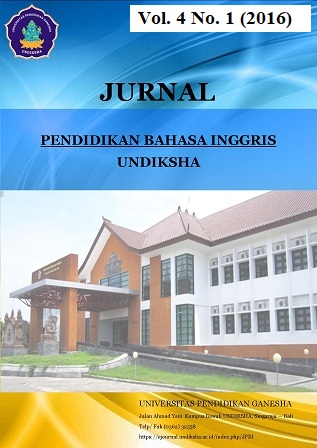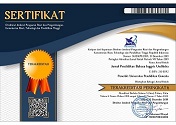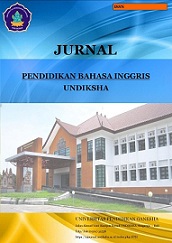Diglossia Phenomenon of Balinese Variety in Sanda Village
DOI:
https://doi.org/10.23887/jpbi.v4i1.7892Abstract
FENOMENA DIGLOSIA PADA VARIASI BAHASA BALI DI DESA SANDA Ni Wayan Paramita Dewi Pendidikan Bahasa Inggris, Fakultas Bahasa dan Seni Universitas Pendidikan Ganesha Singaraja, Indonesia Abstrak Penelitian ini merupakan penelitian deskriptif kualitatif yang bertujuan untuk (1) menyelidiki situasi diglossic terjadi di Desa Sanda, Kabupaten Tabanan, (2) menyelidiki faktor yang mempengaruhi fenomena diglosia di desa Sanda. Penelitian ini dilakukan di Sanda, Pupuan Kecamatan, Kabupaten Tabanan. Subyek penelitian ini adalah orang-orang dari Sanda dalam lima domain: (1) (2) lingkungan (3) friendship (4) (5) pendidikan agama keluarga. Instrumen yang digunakan dalam pengumpulan data adalah peneliti, perekam, catatan lapangan, wawancara dipandu, dan laptop. Metode yang digunakan dalam penelitian ini adalah wawancara, observasi dan perekaman. Ada empat langkah yang dilakukan dalam menganalisis data: pengumpulan data, reduksi data, display data, dan data kesimpulan / verifikasi. Hasil penelitian menunjukkan bahwa situasi diglossic terjadi di desa Sanda, itu terlihat dari dua varietas bahasa yang digunakan di Sanda, yaitu: (1) ragam tinggi ditemukan dalam penggunaan basa alus, (2) ragam rendah ditemukan di kesamen basa dan basa kasar dari Bali. Ada dua faktor utama yang mempengaruhi diglosia fenomena di desa Sanda: (1) kelas sosial (2) konteks sosial.Kata Kunci : Diglosia, Variasi Bahasa Bali, Desa Sanda
DIGLOSSIA PHENOMENON OF BALINESE VARIETY IN SANDA VILLAGE Ni Wayan Paramita Dewi English Education Department, Faculty of Language and Art Ganesha University of Education Singaraja, Indonesia ABSTRACT This research is descriptive qualitative research which aimed at (1) investigating the diglossic situation occurring in Sanda village, Tabanan regency, (2) investigating the factors that influence the phenomenon of diglossia in Sanda village. This study was conducted at Sanda, Pupuan sub-district, Tabanan regency. The subjects of this study were the people of Sanda in five domains: (1) family (2) neighborhood (3) friendship (4) religion (5) education. The instruments used in gathering the data were researcher, recorder, field note, guided interview, and laptop. The methods used in this research were interviews, observation and recording. There were four steps done in analyzing the data: data collection, data reduction, data display, and data conclusion/verification. The results showed that diglossic situation occurring in Sanda village, it seen from the two varieties of language used in Sanda, that is: (1) High variety discovered in basa alus usage, (2) Low variety discovered in basa kesamen and basa kasar of Balinese. There were two main factors influencing diglossia phenomenon in Sanda village: (1) social class (2) social context.
keyword : Diglossia, Balinese variety, Sanda village
Published
2016-07-26
Issue
Section
Articles
License
Authors who publish with the Jurnal Pendidikan Bahasa Inggris Undiksha agree to the following terms:- Authors retain copyright and grant the journal the right of first publication with the work simultaneously licensed under a Creative Commons Attribution License (CC BY-SA 4.0) that allows others to share the work with an acknowledgment of the work's authorship and initial publication in this journal
- Authors are able to enter into separate, additional contractual arrangements for the non-exclusive distribution of the journal's published version of the work (e.g., post it to an institutional repository or publish it in a book), with an acknowledgment of its initial publication in this journal.
- Authors are permitted and encouraged to post their work online (e.g., in institutional repositories or on their website) prior to and during the submission process, as it can lead to productive exchanges, as well as earlier and greater citation of published work. (See The Effect of Open Access)













